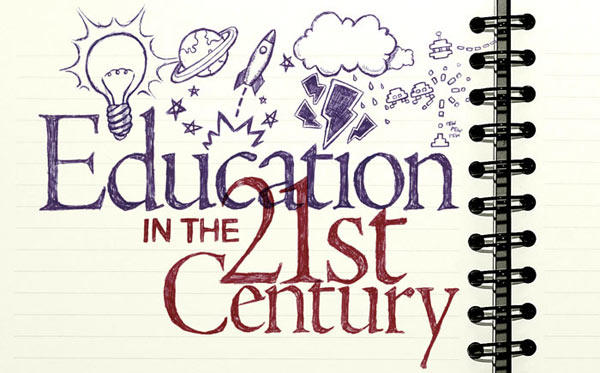
Career and Technical Education (CTE) in the 21st century is nothing like the vo-tech classes your father took. Job readiness and academic excellence go hand-in-hand for today’s high school students who are preparing for both college and careers.
In 2006, the Florida Legislature passed a bill requiring students to take at least four courses in a major area of interest. Since then, highly competitive career academies have evolved throughout Florida high schools, exposing students to diverse fields, such as television production, medical and health sciences, culinary arts, early childcare, engineering, business, and more. Sumter County’s three high schools offer 15 career academies, and almost 75 percent of high school seniors are enrolled in one.
Don’t think, however, that career academy students are just learning a trade and getting to skip the normal high school classes that we all loved to hate, like algebra, chemistry, or history. Career academy students are highly motivated and, in most cases, must maintain a high grade point average in order to be accepted into an academy. The two- or three-year sequences of career and technical courses go above and beyond the academic classes that students are required to take.
“Career academies are not just about training students for jobs,” says Christine Burk, career academy specialist for Sumter County Schools. “The academic curriculum is rigorous and satisfies college-entry requirements as well as having a career theme.”
Burk says that the career academies are popular with students because they see the relevance to the real world. Partnerships with businesses and industries are prevalent, often giving students hands-on experiences.
Some of the academies—known as Career and Professional Education (CAPE) Academies—even offer industry certifications that certainly benefit the students when they graduate. While some students graduate with job readiness skills and pursue jobs immediately, most career academy graduates plan to further their education at two-year schools or universities. All agree that the career academies have exposed them to new possibilities and will be stepping stones to finding fulfilling careers.
Meet a few of Sumter County’s most talented seniors who exemplify a 21st century education:
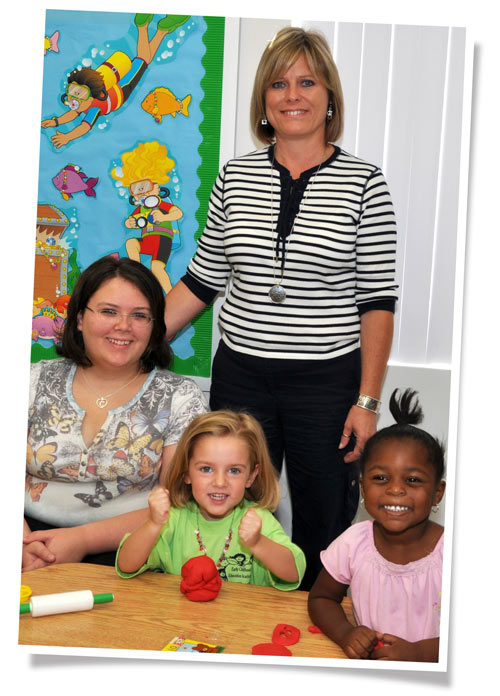
‘Working With Kids Is My Favorite’
Carrie Johnson
South Sumter High School
Career Academy:
Early Childhood Education
Career Plans:
English Teacher
About the same time that Carrie Johnson is marching for her high school diploma next spring, she will also receive an Associate of Arts degree from Lake-Sumter Community College (LSCC).
Carrie is a dual enrollment student, meaning she takes college courses before starting her day at South Sumter High School. She always knew that she wanted to be a teacher. When she heard that the Early Childhood Education Academy would give her hands-on experience at South Sumter’s on-site day care center, she signed up.
“Working with the kids is my favorite part of the day,” says Carrie, who is from Webster. “My biggest surprise about the academy was how much time we actually spend with the children.”
Seniors like Carrie are encouraged to sit for the Early Childhood Professional Certification test that qualifies them to work in day care centers. It’s part of the job-readiness goal that the Florida Career and Professional Education Act of 2007 outlined to ensure that career and technical education programs are academically rigorous, as well as relevant to the workplace.
“The certification is something they take with them, whether they are going to work in a day care or on to college,” explains instructor Debbie Hileman. “Most students go to college and become elementary education teachers, while others have eventually opened their own day care centers.”
Debbie, who has taught at South Sumter for 20 years, explains that the career academy has also helped a few students realize that working with children is not for them.
“But they’ve learned what to look for when they have to put their own kids in a day care program,” she says.
Most of her students are like Carrie and choose to be in the Early Childhood Education program. By the time students graduate, they will have had 480 hours of working with children, which is required for state certification.
“Being creative and enjoying children is important for students who want to be in this career academy,” advises Carrie. “And sometimes it’s all about studying.”

‘Learning Something New Every Day’
Terrence Neal
South Sumter High School
Career Academy
Medical
Career Plans
Anesthesiologist or Nurse Anesthetist
Although Terrence Neal will leave South Sumter High School as a certified nursing assistant next spring, his goals include much more study in a health-related field. He plans to attend the University of Florida, where he’ll major in either biology or nursing. Then he hopes to pursue a career as an anesthesiologist or nurse anesthetist.
The varsity basketball player and track star wasn’t always so focused on a healthcare career, though.
“I took the first healthcare class to see what it was all about,” says Terrence, who briefly considered the Criminal Justice Academy. “I really enjoyed the hands-on projects and learning something new every day.”
Terrence applied for South Sumter’s highly competitive Medical Career Academy and was accepted in his junior year. Instructor Heather Kadur describes Terrence as a “model student” who is dependable and dedicated—qualities she looks for in every student who applies to the academy.
“Only the top 25 students who apply are accepted,” explains Heather, who is also a registered nurse. “The standards are very high and rigorous.”
About 95 percent of students who enter the Medical Career Academy pursue career opportunities in healthcare fields. Although every senior sits for the CNA exam and could pursue jobs as certified nursing assistants, most of her students go on to college for further training. Since the Medical Career Academy was created, graduates of the program have become emergency medical technicians, paramedics, dental assistants, therapists, and nurses.
Seniors in the academy are with Heather for three hours a day in a suite of classrooms that resembles a small medical center, complete with examining rooms and hospital beds. With a grant from Workforce Florida, Heather designed the area as a realistic hospital experience.
Terrence, who is also a dual‑enrollment student at LSCC, says that even if students don’t pursue a health career, the Medical Career Academy can give them knowledge that will be beneficial in life.
“Even if you are just going to the doctor, you’ll know the medical terminologies,” says Terrence. “Being able to read and understand your own medical chart can be really helpful.”
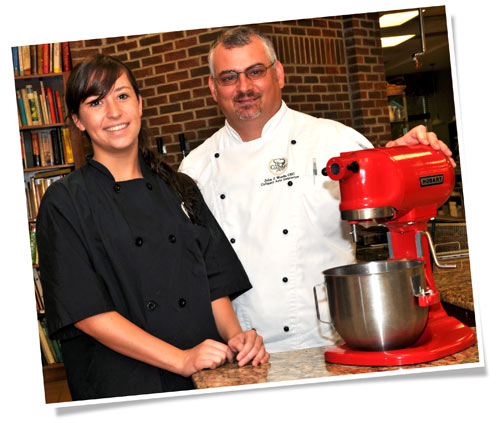
‘I Wanted To Try Everything’
Kelsey Whitman
The Villages High School
Career Academy
Culinary Arts
Career Plans
Pastry Chef
Kelsey Whitman loves sweets but not the way that most people do. Not only does the slim senior love making desserts in the Culinary Arts Career Academy at The Villages High school, but she also opens the bakery section at Panera Bread on weekends.
“At first I wanted to try everything,” says Kelsey, “but after a while it’s easy to resist.”
Her will power is propelling her toward a career as a pastry chef. She hopes to attend Johnson & Wales University’s culinary program in Miami next year because of its renowned pastry curriculum. Kelsey’s love of cooking began at home, where she enjoys preparing new recipes for her parents, Sharon and Steve Whitman of Oxford.
Culinary Arts Instructor John Woods emphasizes that the two-year program is not just about cooking.
“We teach a lot of business and life skills, too,” says John. “All the students are required to write a business plan and they learn how to look for better food prices.”
Seniors also operate a “restaurant” one day a week for different groups or clubs. The goal is to make a small profit, which is used to buy equipment for the commercial-size kitchen or to fund culinary scholarships.
Woods credits the Food Network for the growing interest in culinary arts. This year he has 30 seniors, compared with 16 last year. Many of the students are considering restaurant or catering careers, but not all of them and that’s okay with the instructor who is also a certified executive chef.
“The program is still a success even if you just get students to cook for themselves instead of eating fast food every night,” says John. “The biggest reward for me is when parents tell me their child cooked for them.”
John presides over the large kitchen on the first floor of The Villages High School that was built specifically for the culinary arts program. All of the students rotate kitchen duties from prep to clean up. Kelsey advises students to enroll only if they are really interested in cooking.
“You have to do stuff as part of a team, and you can’t just sit around,” she says. “It’s not just an easy grade.”
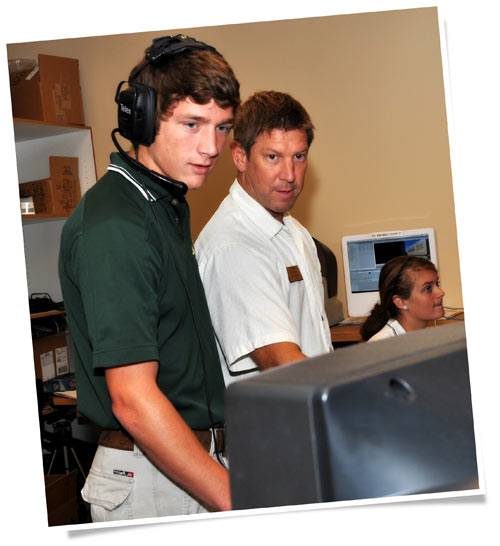
‘Creating A Story From Scratch’
Shane Fussell
The Villages High School
Career Academy:
Communications/Television Production
Career Plans:
Engineering or Television Production
Shane Fussell loves math and science, and he seemed headed toward an engineering career. Then, last year, he discovered how much fun broadcasting could be when he enrolled in the Television Production Career Academy at The Villages High School.
“I’ve really enjoyed the work, and it gave me a new outlook on job possibilities,” says the honor student.
Shane’s experience in the career academy studio has already opened the door to part-time opportunities. He’s been part of WVLG-Radio 640’s Buffalo Fun Team and during the summer he worked behind the scenes on remotes for the radio station.
“Watching students like Shane is rewarding,” says Ken Archer, director of the academy and a former award-winning television news producer himself. “Seeing the students produce the quality broadcasts that they do makes a teacher smile.”
The professional-looking studio on the second floor of The Villages High School is run completely by students. Their newscast, known as Buffalo News 13, is aired throughout the school every morning. The students rotate positions, such as news anchors and camera operators.
Shane, however, is the year-long news director, a position he earned as a junior. He keeps everything running behind the scenes.
“My favorite part is creating a story from scratch,” says Shane. “I like being able to express myself through video.”
The academy has grown dramatically. More than 50 students are enrolled this year, compared to 24 last year. Three years ago, the program had only five students. Several of Archer’s former students are now studying television production at the University of Florida and University of Central Florida.
As for Shane, he is not quite ready to make a definite career commitment while he’s still in high school.
“I’m still torn between this and engineering,” he says. “I want to enjoy high school and not try to decide right now what my life’s work will be.”
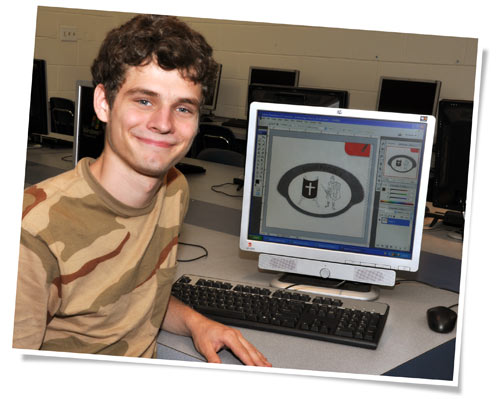
‘Programs Here Help With Engineering’
Garth Edwards
Wildwood High School
Career Academy
Digital Design
Career Plans
Aerospace Engineer
Although Garth Edwards is a star student in the Digital Design Career Academy at Wildwood High School, he has not wavered from his goal of becoming an aerospace engineer.
“I’ve known what I wanted to do since the sixth grade,” says the vice president of the student council. “The programs that I’m learning here will help me with the CAD programs that are used in aerospace engineering.”
Garth hopes to attend either the U.S. Air Force Academy or the University of Florida next year. In the meantime, though, he’s enjoying the creative side of one of Sumter County’s newest career academies. When he’s not practicing his tenor sax or taking dual enrollment classes at LSCC, Garth often can be found after school in the digital design lab putting in some extra time on projects.
Wildwood High’s Digital Design Academy is beginning its third year, and motivated students like Garth have already contributed to its success. The advanced students run a small business out of the program, creating everything from banners and T-shirts to printed posters and invitations for local businesses. All the money is put back into the program for supplies and equipment.
Students learn about graphic arts and digital design from instructor Melissa Smith, an experienced graphic artist herself.
“All of the students must take a basic business class first,” says Smith, who is beginning her second year as the academy’s instructor. “Regardless of what industry they choose for a career, they will know what it takes to run a business. This program gives them an incredible advantage.”
Career-minded students can come away with Adobe software certifications that are considered industry standards of excellence and are highly sought-after in digital design careers.
Garth says that the academy is a step in the right direction for him. He likes to create things, including building his own computers.
“Right now I have five taken apart in my room,” he says with a grin.





